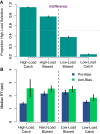The Subjective Value of Cognitive Effort is Encoded by a Domain-General Valuation Network
- PMID: 30850512
- PMCID: PMC6520500
- DOI: 10.1523/JNEUROSCI.3071-18.2019
The Subjective Value of Cognitive Effort is Encoded by a Domain-General Valuation Network
Abstract
Cognitive control is necessary for goal-directed behavior, yet people treat cognitive control demand as a cost, which discounts the value of rewards in a similar manner as other costs, such as delay or risk. It is unclear, however, whether the subjective value (SV) of cognitive effort is encoded in the same putatively domain-general brain valuation network implicated in other cost domains, or instead engages a distinct frontoparietal network, as implied by recent studies. Here, we provide rigorous evidence that the valuation network, with core foci in the ventromedial prefrontal cortex and ventral striatum, also encodes SV during cognitive effort-based decision-making in healthy, male and female adult humans. We doubly dissociate this network from frontoparietal regions that are instead recruited as a function of decision difficulty. We show that the domain-general valuation network jointly and independently encodes both reward benefits and cognitive effort costs. We also demonstrate that cognitive effort SV signals predict choice and are influenced by state and trait motivation, including sensitivity to reward and anticipated task performance. These findings unify cognitive effort with other cost domains, and suggest candidate neural mechanisms underlying state and trait variation in willingness to expend cognitive effort.SIGNIFICANCE STATEMENT Subjective effort costs are increasingly understood to diminish cognitive control over task performance and can thus undermine functioning across health and disease. Yet, we are only beginning to understand how decisions about cognitive effort are made. A key question is how subjective values are computed. Recent work suggests that the value of cognitive effort might be computed by networks that are distinct from those involved in other domains like intertemporal and risky decision-making, implying distinct mechanisms. Here we demonstrate that the domain-general network also encodes effort-discounted value, linking cognitive effort closely with other domains. Our results thus elucidate key mechanisms supporting decisions about cognitive effort, and point to candidate neural targets for intervention in disorders involving impaired cognitive motivation.
Keywords: cognitive control; cognitive effort; decision-making; motivation; subjective value; vmPFC.
Copyright © 2019 the authors.
Figures








References
-
- Benjamini Y, Hochberg Y (1995) Controlling the false discovery rate: a practical and powerful approach to multiple testing. J Royal Stat Soc B 57:289–300.
Publication types
MeSH terms
Grants and funding
LinkOut - more resources
Full Text Sources
Other Literature Sources
